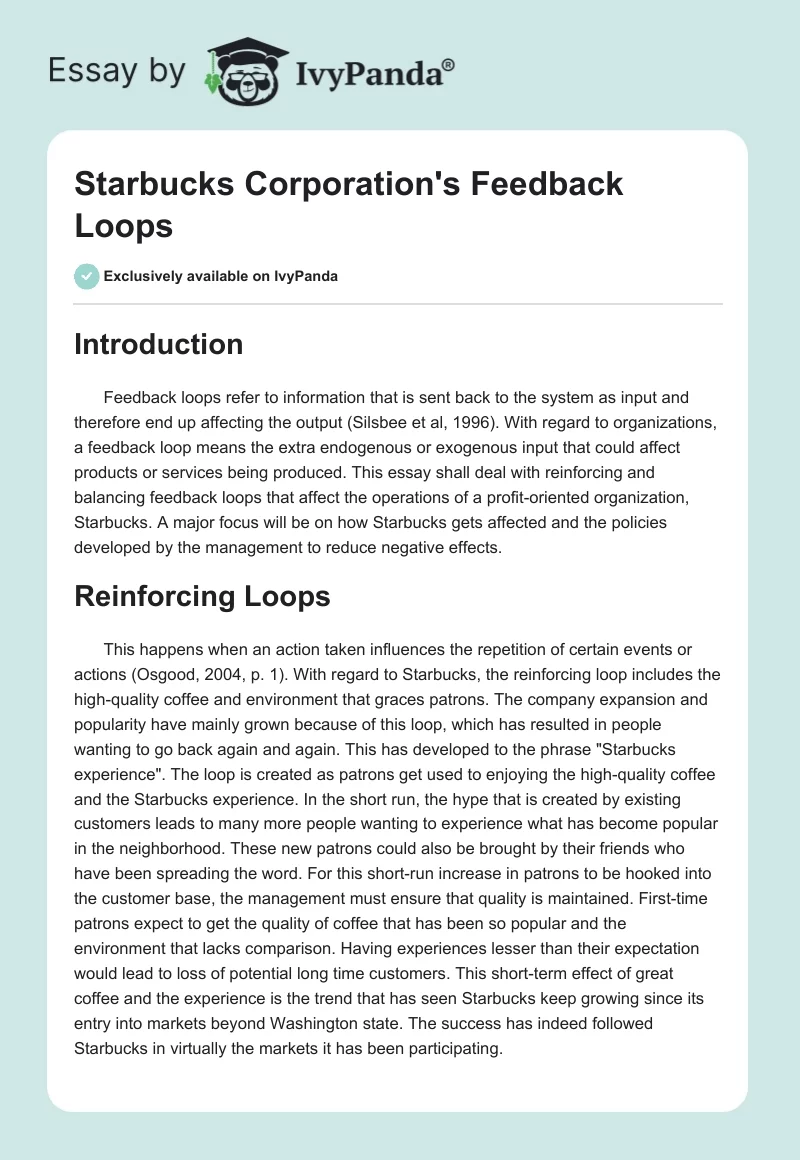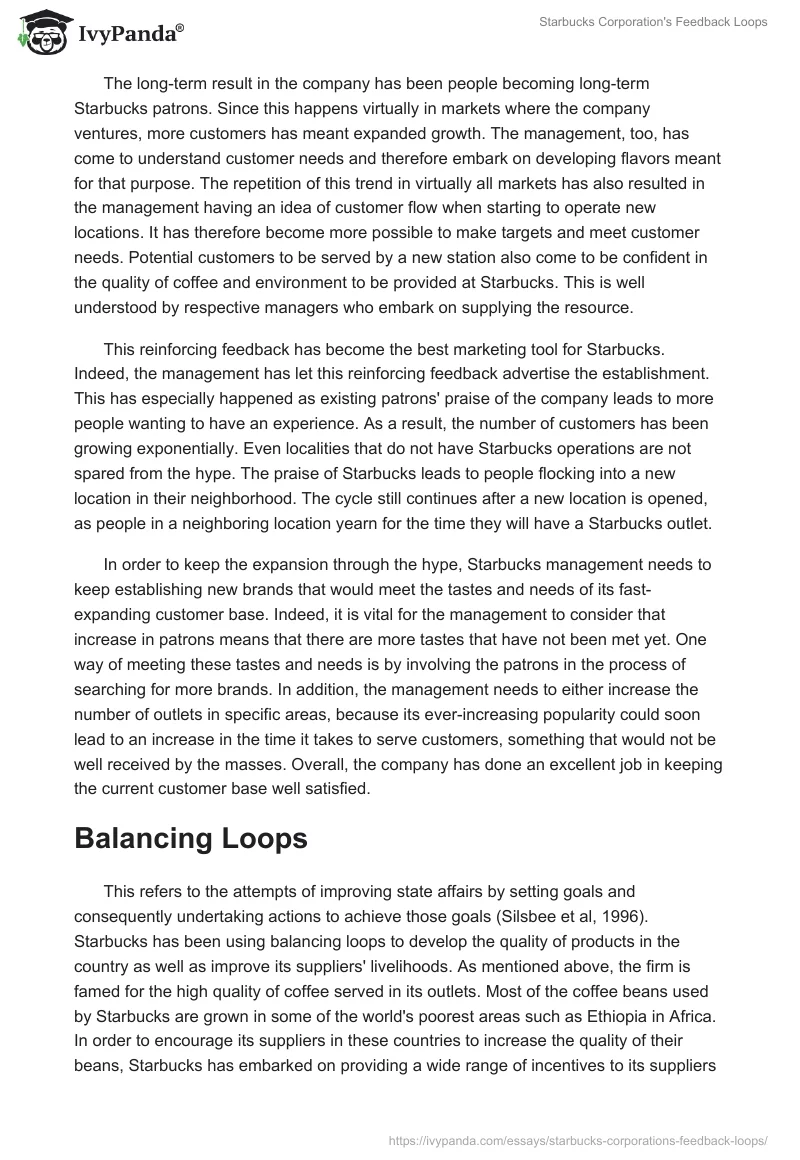Introduction
Feedback loops refer to information that is sent back to the system as input and therefore end up affecting the output (Silsbee et al, 1996). With regard to organizations, a feedback loop means the extra endogenous or exogenous input that could affect products or services being produced. This essay shall deal with reinforcing and balancing feedback loops that affect the operations of a profit-oriented organization, Starbucks. A major focus will be on how Starbucks gets affected and the policies developed by the management to reduce negative effects.
Reinforcing Loops
This happens when an action taken influences the repetition of certain events or actions (Osgood, 2004, p. 1). With regard to Starbucks, the reinforcing loop includes the high-quality coffee and environment that graces patrons. The company expansion and popularity have mainly grown because of this loop, which has resulted in people wanting to go back again and again. This has developed to the phrase “Starbucks experience”. The loop is created as patrons get used to enjoying the high-quality coffee and the Starbucks experience. In the short run, the hype that is created by existing customers leads to many more people wanting to experience what has become popular in the neighborhood. These new patrons could also be brought by their friends who have been spreading the word. For this short-run increase in patrons to be hooked into the customer base, the management must ensure that quality is maintained. First-time patrons expect to get the quality of coffee that has been so popular and the environment that lacks comparison. Having experiences lesser than their expectation would lead to loss of potential long time customers. This short-term effect of great coffee and the experience is the trend that has seen Starbucks keep growing since its entry into markets beyond Washington state. The success has indeed followed Starbucks in virtually the markets it has been participating.
The long-term result in the company has been people becoming long-term Starbucks patrons. Since this happens virtually in markets where the company ventures, more customers has meant expanded growth. The management, too, has come to understand customer needs and therefore embark on developing flavors meant for that purpose. The repetition of this trend in virtually all markets has also resulted in the management having an idea of customer flow when starting to operate new locations. It has therefore become more possible to make targets and meet customer needs. Potential customers to be served by a new station also come to be confident in the quality of coffee and environment to be provided at Starbucks. This is well understood by respective managers who embark on supplying the resource.
This reinforcing feedback has become the best marketing tool for Starbucks. Indeed, the management has let this reinforcing feedback advertise the establishment. This has especially happened as existing patrons’ praise of the company leads to more people wanting to have an experience. As a result, the number of customers has been growing exponentially. Even localities that do not have Starbucks operations are not spared from the hype. The praise of Starbucks leads to people flocking into a new location in their neighborhood. The cycle still continues after a new location is opened, as people in a neighboring location yearn for the time they will have a Starbucks outlet.
In order to keep the expansion through the hype, Starbucks management needs to keep establishing new brands that would meet the tastes and needs of its fast-expanding customer base. Indeed, it is vital for the management to consider that increase in patrons means that there are more tastes that have not been met yet. One way of meeting these tastes and needs is by involving the patrons in the process of searching for more brands. In addition, the management needs to either increase the number of outlets in specific areas, because its ever-increasing popularity could soon lead to an increase in the time it takes to serve customers, something that would not be well received by the masses. Overall, the company has done an excellent job in keeping the current customer base well satisfied.
Balancing Loops
This refers to the attempts of improving state affairs by setting goals and consequently undertaking actions to achieve those goals (Silsbee et al, 1996). Starbucks has been using balancing loops to develop the quality of products in the country as well as improve its suppliers’ livelihoods. As mentioned above, the firm is famed for the high quality of coffee served in its outlets. Most of the coffee beans used by Starbucks are grown in some of the world’s poorest areas such as Ethiopia in Africa. In order to encourage its suppliers in these countries to increase the quality of their beans, Starbucks has embarked on providing a wide range of incentives to its suppliers (Starbucks, 2006, 1). The company has been paying higher prices for the beans compared to the regular ones in the international markets. The high price for their commodities is encouraging farmers to take care of their crops so as to get better returns in the future. The company is on the other hand benefiting from the high-quality beans that help in enhancing its position as the market leader.
The short-run effect of this policy includes the establishment of a working relationship between the company and its suppliers. The loop will however have strong effects in the long run. Starbucks will have an assured long-term supply of high-quality coffee. This will mean consistent high varieties of coffee in the company’s outlets. This will therefore help the company achieve its long-term goals, vision, and mission. At the same time, the company will in the long run benefit the masses in developing countries that supply it with the best coffees. Performing this act as part of its CSR (Corporate Social responsibility). Will endear the company to its clients who would feel more satisfied to understand that their coffee money is being used to benefit the hard-working farmers in developing nations, not some commodity speculators in Chicago or New York commodity markets. For the company to benefit from this balancing loop, the policy of supporting farmers in developing nations should be taken as both CSR and as a business relationship. This business relationship between the two parties will; benefit the masses better that handouts in form of higher prices. Any form of handout could end up not helping the people because it could lead to development of paternalism within in respective societies. Other than relying on the beans from specialised areas, Starbucks management should still continue buying from other high grade areas. This will help caution against any natural calamities that could hinder supply from its primary sources.
References
Osgood, N. (2004). Project Dynamics. Cambridge: MIT.
Silsbee, D., Nyquist, C., Larsen, K., McInerney, C. and Santos, A. (1996). Learning Organizations. 2008. Web.
Starbucks. (2006). Fair Trade Factsheets. Starbucks: Seattle.


